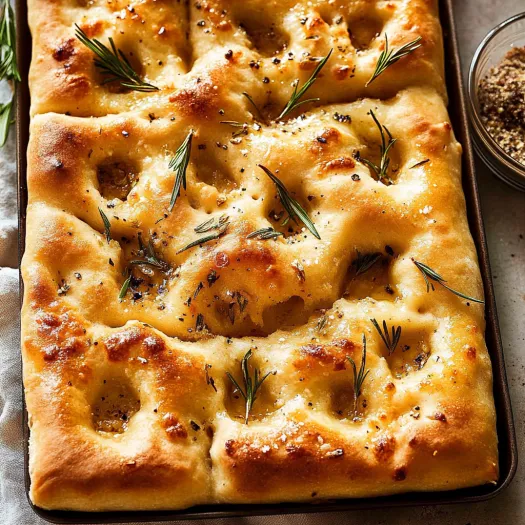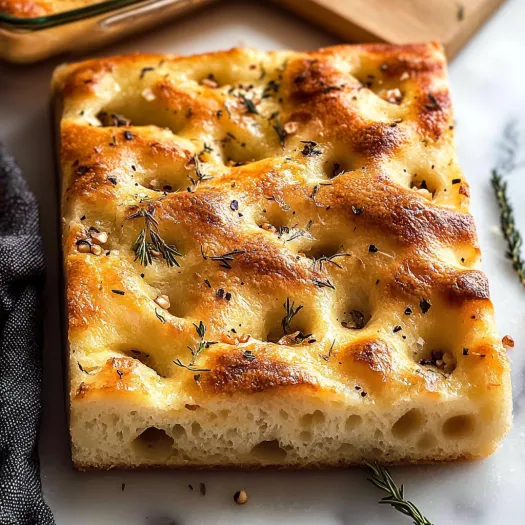 Pin it
Pin it
Bari-style focaccia delivers an incredible combo of soft insides and crackling exterior for a true taste of Italy that stands out from typical breads. What makes it special? The surprise potato mixed into the dough creates an amazingly tender, chewy texture that'll have you grabbing another slice. This Puglian favorite turns basic stuff into something amazing - not through fancy tricks but through good old-fashioned patience and know-how.
I first came across this bread during my food adventures in Italy's south when a sweet nonna invited a few of us travelers to cook with her. We couldn't speak each other's language, but watching her hands work told us everything about this treasured bread. When I made it back home, that first batch took me straight back to her sunny kitchen filled with olive oil smells and lively Italian chatter. Now my friends always ask for the recipe whenever I serve it.
Key Ingredients Breakdown
- Mashed potato: Adds that can't-put-your-finger-on-it softness and feeds the yeast for better rising
- Bread flour: Gives the right chewiness to handle all the water in this wet dough
- Extra virgin olive oil: Brings that Mediterranean punch and helps make the outside crispy
- Instant yeast: Makes the dough rise perfectly without the fuss of activating it first
- Sea salt: Boosts all the flavors inside and adds a nice crunch when sprinkled on top
- Warm water: At about 40°C, it wakes up the yeast without killing it
- Cherry tomatoes: Turn sweet and intense during baking and make the bread look beautiful
Bread Making Process
- Getting Started:
- First, cook a medium potato until it's fork-tender, about twenty minutes. Drain it well and mash it smooth with no lumps. In a big bowl, put 500 grams of bread flour and add your yeast, salt, and sugar, then mix them up really well. Make a hole in the middle, pour in your warm water and olive oil. Stir with a wooden spoon until it looks shaggy, then mix in your mashed potato until everything's combined.
- First Growth:
- With wet hands so the dough won't stick, fold it over itself a few times to create some tension on the surface, even though it feels sticky. Form a loose ball, cover your bowl with plastic wrap or a damp towel, and put it somewhere warm (around 24°C) with no drafts for half an hour. You'll know it's working when it gets bigger and little bubbles start forming.
- Making It Stronger:
- Move your partly risen dough to another bowl that's got plenty of olive oil in it so it won't stick later. Grab the edge farthest from you, stretch it up a bit, and fold it to the middle. Turn the bowl a quarter turn and do the same thing, repeating until you've made six folds all the way around. Cover it again and let it sit in that warm spot for another thirty minutes while it builds strength and flavor.
- Getting the Pan Ready:
- Choose a metal baking pan about 26 by 20 centimeters for the right thickness. Pour a good tablespoon of olive oil all over the bottom, making sure to get the corners and sides. While waiting, get your toppings ready - slice tomatoes, measure out olives, and maybe make some garlic-infused oil by warming minced garlic in olive oil until it smells good but doesn't brown. Get any fresh herbs ready too.
- Final Shaping:
- Put your dough in the oiled pan and gently push it toward the edges with your oily fingertips, but don't tear it. Leave a little space at the edges since it'll still grow some more. Cover loosely with plastic wrap and put it back in that warm spot for about forty minutes until it looks puffy with air bubbles underneath. That's when you know it's ready for toppings.
- Adding the Good Stuff:
- Push your fingertips deep into the puffy dough to make those classic dimples while letting out some gas. Drizzle more olive oil all over and watch it pool in the little holes. Add your toppings across the surface - maybe press tomato halves cut-side up into the dough, scatter some olives around, or drizzle on that garlic oil before sprinkling herbs. Finish with a generous pinch of sea salt all over to bring out all the flavors.
- Baking It Up:
- Put your focaccia in a 220°C oven, middle rack for even heat. Bake about twenty-five minutes until it's deep golden brown on top and crispy around the edges. You can tell it's done when tapping the bottom makes a hollow sound. Move it right away to a cooling rack so steam can escape and the bottom stays crisp.
 Pin it
Pin it
I love potato-enriched focaccia because it reminds me of watching my Italian neighbor bake similar bread for neighborhood get-togethers when I was a kid. She told me how during tough times, adding potato made expensive flour go further while actually making the bread taste better. This clever solution turned necessity into something wonderful that's still valued today despite our modern abundance. Every time I mix potato into my dough, I'm keeping this smart tradition alive and appreciating how simple ingredients become something amazing through tried-and-true methods.
Tasty Serving Ideas
Enjoy your focaccia while it's still warm with some aged balsamic and good olive oil for a simple but fancy starter. You could also put out some thin-sliced prosciutto and fresh mozzarella so people can make their own little sandwiches at casual parties. In summer, serve it with small glasses of cold gazpacho for a refreshing combo that's perfect for eating outside.
Regional Variations
Try topping your focaccia with sweet caramelized onions before baking, a favorite way to make it in northern Italy. Or push small cubes of aged pecorino cheese into the surface before baking for pockets of salty goodness throughout. For a taste of Liguria, cover the top with thin potato slices, rosemary and flaky salt to make a heartier version that goes great with roasted meats in fall.
Keeping It Fresh
Once your focaccia has cooled completely, wrap it in parchment paper then a kitchen towel to keep the moisture just right for up to two days. You can bring day-old bread back to life by lightly sprinkling it with water and warming it in a 160°C oven for about ten minutes to crisp up the outside again. Another idea is to slice leftover focaccia horizontally and use it as a base for open-faced sandwiches with Mediterranean toppings. You can even freeze wrapped pieces for up to a month - just thaw them completely before reheating.
 Pin it
Pin it
This Bari-style focaccia shows off everything that makes traditional Italian baking so special by turning basic ingredients into something amazing through careful technique. Over the years, I've noticed that authentic regional foods usually have fewer ingredients than modern versions but need more attention to the process. The magic happens when you understand fermentation, moisture levels, and temperature control - not by adding fancy stuff. Whether you're serving this bread with a simple soup or as the first course of a fancy dinner party, its down-to-earth elegance creates memorable meals that connect us to hundreds of years of Mediterranean cooking traditions.
Frequently Asked Questions
- → What's the purpose of potato in this bread?
- Mashed potato keeps the inside soft and moist while delivering a crispy crust. It also slows staling, so the bread stays fresher longer.
- → Can I swap bread flour with all-purpose flour?
- Sure, but the texture will be slightly softer and less chewy. Bread flour works best for that perfect artisan feel.
- → Why press dimples into the dough?
- Dimples trap olive oil, making every bite flavorful. They also help even out the dough's rise while baking.
- → Can I prep the dough in advance?
- It's better to make this dough fresh. Storing it in the fridge too long could hinder its rise, leading to denser bread.
- → What's the best way to keep leftover focaccia fresh?
- Store it in a zip-top bag for a couple days. For the best results, heat it back up in the oven to revive the crunch.
- → Why cook the garlic before adding it as a topping?
- Raw garlic burns easily at focaccia's baking temps. Cooking it in oil softens it and prevents scorching while creating a lovely golden color.
